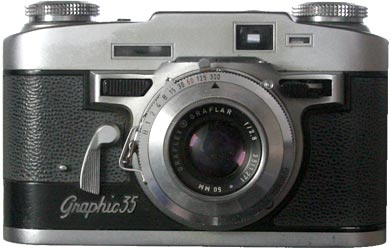
Approx. dates of manufacture: 1955 to 1957
Approx. original price: $90
Approx. street value: $20
Graflex is my favorite American camera company. Kodak could make a good camera when they wanted to, but preferred to churn out boatloads of Brownies. Ansco thrived on junk. Argus was a little better but always seemed 25 years behind. Clarus was a Leica copy. Bell+Howell and Revere were cine makers who only dabbled in still cameras.
Graflex was quality and went their own way—mostly. They were leaders in their field and innovative and interesting. The problem with Graflex is that they lost their way after Kodak had to let them go as part of an anti-trust settlement. They did well in the 1930s and 40s, but really they were coasting. They honed and refined their products, but their bread-and-butter remained their large format press cameras, the Graflex and Speed Graphic. When commercial and press photographers moved down to medium and miniature formats in the 50s, Graflex didn't really have anything to offer. They tried a number of experiments but mostly failed. They acquired the failed Ciro, which didn't really do them any favors since Ciro products weren't much account. They partnered with the Japanese maker Kowa, which made quality equipment but never did well in the USA and had a wicked reputation for being difficult to repair. Graflex put a lot of energy into making a killer press camera (the XL) when everyone was buying Leica Ms and Nikon Fs. They couldn't get it right.
s.jpg) This is one of Graflex's earlier experiments, an updating of the failed Ciro 35. The obvious difference is the push-button focusing, as opposed to the slide levers on the Ciro. Another is that this one has a German Prontor SVS shutter and Rodenstock glass (called Graftar on the camera). It came in both ƒ/3.5 and ƒ/2.8 versions (mine is the latter).
This is one of Graflex's earlier experiments, an updating of the failed Ciro 35. The obvious difference is the push-button focusing, as opposed to the slide levers on the Ciro. Another is that this one has a German Prontor SVS shutter and Rodenstock glass (called Graftar on the camera). It came in both ƒ/3.5 and ƒ/2.8 versions (mine is the latter).
There's also a weird feature to make flash exposure calculation easier; they called it Speedomatic. There are color-coded bands on the distance scale which correspond to color codes next to the aperture ring. The idea is that you set the camera to synch speed, then focus and see which color band you're on. If it's blue, you set the aperture to the blue mark on the ring. That worked if you were using a #5b or a Press 25 bulb and Kodachrome or Ektachrome. If not—you're screwed. Later versions had double bands, and still later ones had "universal" bands on the bottom, whereby if you figured out the Guide Number, you could set that and your color-codes would work properly.
According to the excellent book, "Glass, Brass and Chrome," my camera's lens and Speedomatic version meant it was made between April 1956 and July 1957.
Purchased for $1 on eBay, with a case. Not a great camera, but a nice one. This is also one of the last of their American-made cameras. Their later 35mm cameras would come from Japan and Germany.
Camera manual: Orphan Cameras.com
Modern Photography magazine camera test: May 1955


